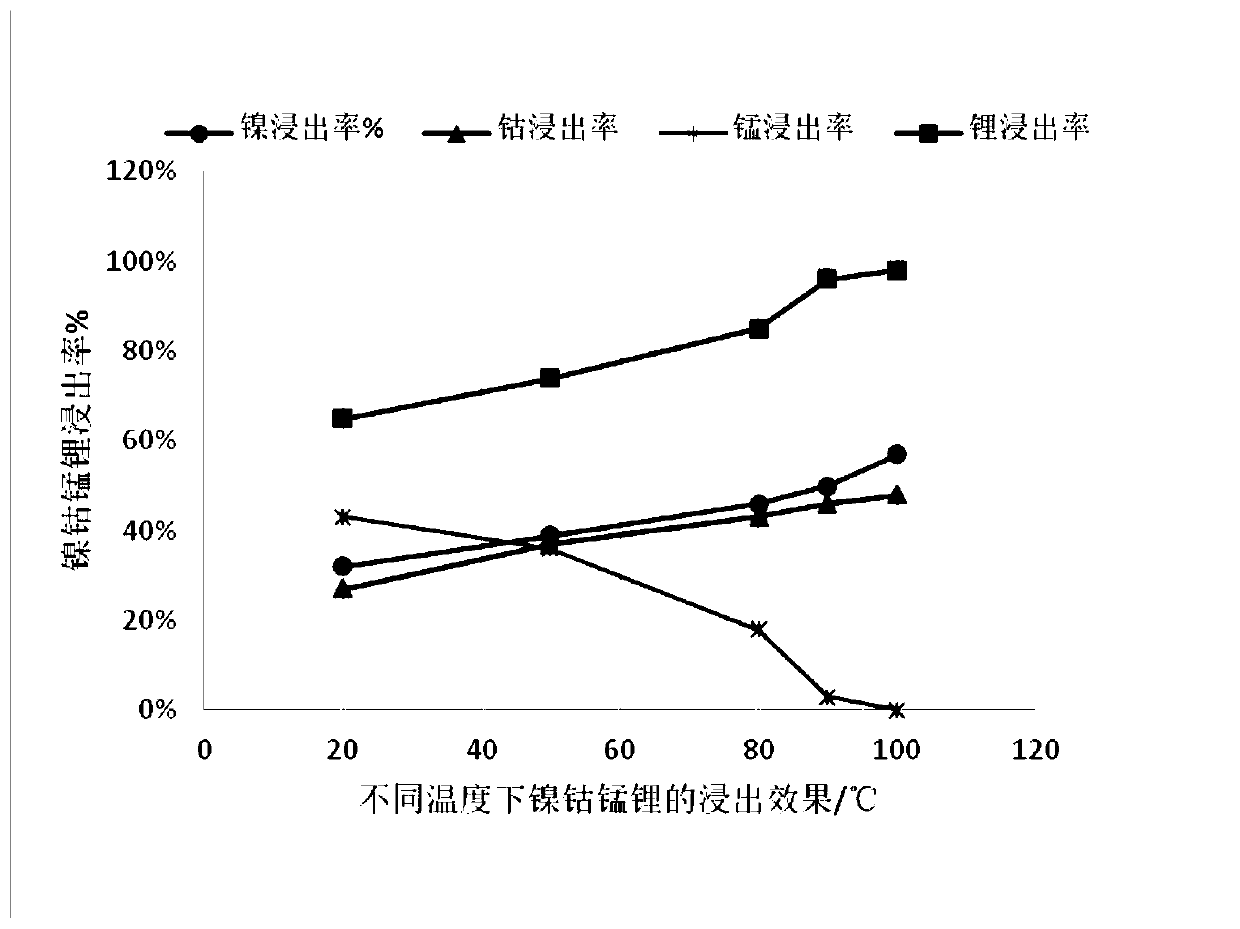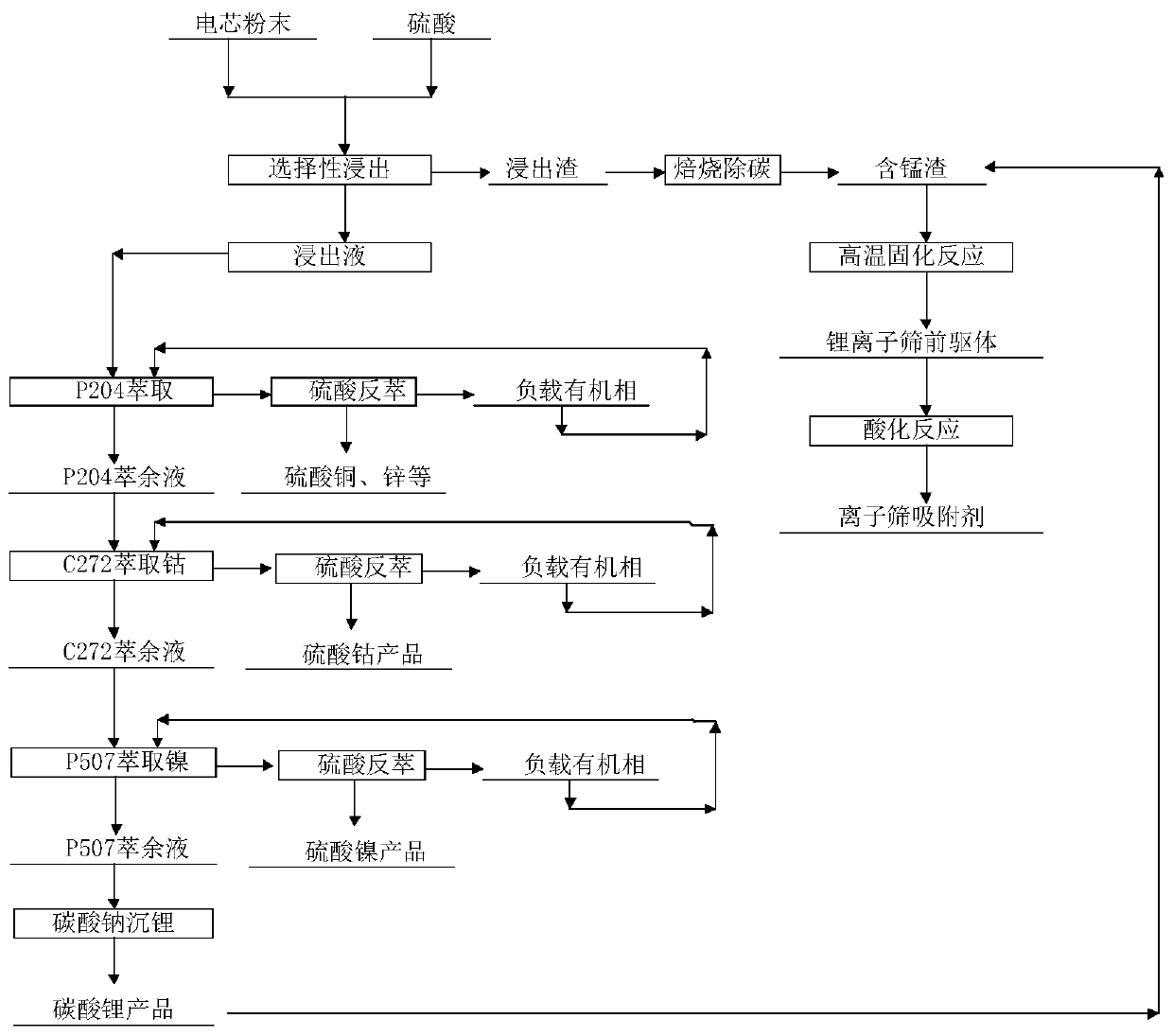Method for preparing lithium-ion sieve from waste lithium-ion batteries
A lithium-ion battery, lithium-ion technology, applied in chemical instruments and methods, lithium compounds, lithium carbonate;/acid carbonate, etc., to achieve the effects of low production cost, simple process flow, and high comprehensive utilization rate
- Summary
- Abstract
- Description
- Claims
- Application Information
AI Technical Summary
Problems solved by technology
Method used
Image
Examples
Embodiment 1
[0041] Example 1: A method for preparing lithium-ion sieves using waste lithium-ion batteries
[0042] Include the following steps in order:
[0043]Take 50g of ternary waste lithium battery cell powder, add 4mol / L sulfuric acid, stir and react at 40°C for 90min, then filter to obtain leaching residue and a solution containing nickel-cobalt-manganese-lithium (leaching rate see attached figure 1 ), adjust the pH of the filtrate ≈ 4.2~4.5, use the extractant P204 to extract and remove impurities, remove impurities such as copper, zinc, calcium, magnesium, iron, manganese, and the raffinate contains copper, zinc, calcium, magnesium, iron, and manganese. Nickel-cobalt-lithium sulfate solution less than 10mg / L;
[0044] For the P204 raffinate, adjust its pH ≈ 5, use the extractant C272 to extract cobalt, and obtain a nickel-lithium sulfate solution containing copper, zinc, calcium, magnesium, iron, manganese, and cobalt less than 10mg / L. After stripping, a solution containing onl...
Embodiment 2
[0048] Embodiment 2: A kind of method utilizing waste lithium ion battery to prepare lithium ion sieve
[0049] Include the following steps in order:
[0050] Take 50g of ternary waste lithium battery cell powder, add 4mol / L sulfuric acid, stir and react at 60°C for 120min, then filter to obtain leaching residue and a solution containing nickel-cobalt-manganese-lithium (leaching rate see attached figure 1 ), adjust the pH of the filtrate to 4.5, use the extractant P204 to extract and remove impurities, remove impurities such as copper, zinc, calcium, magnesium, iron, manganese, and the raffinate contains less than 10mg of copper, zinc, calcium, magnesium, iron, and manganese The nickel cobalt lithium sulfate solution of / L;
[0051] For the P204 raffinate, adjust its pH to 4.8, use the extractant C272 to extract cobalt, and obtain a nickel-lithium sulfate solution containing copper, zinc, calcium, magnesium, iron, manganese, and cobalt that are less than 10 mg / L. After strip...
Embodiment 3
[0055] Example 3: A method for preparing lithium-ion sieves using waste lithium-ion batteries
[0056] Include the following steps in order:
[0057] Take 50g of ternary waste lithium battery cell powder, add 4mol / L sulfuric acid, stir and react at 80°C for 60min, then filter to obtain leaching residue and a solution containing nickel-cobalt-manganese-lithium (leaching rate see attached figure 1 ), adjust the filtrate pH ≈ 4.2-4.5, use the extractant P204 to extract and remove impurities, remove copper, zinc, calcium, magnesium, iron, manganese and other impurities, the raffinate contains copper, zinc, calcium, magnesium, iron, manganese Nickel-cobalt-lithium sulfate solution less than 10mg / L;
[0058] For the P204 raffinate, adjust its pH ≈ 5, use the extractant C272 to extract cobalt, and obtain a nickel-lithium sulfate solution containing copper, zinc, calcium, magnesium, iron, manganese, and cobalt less than 10mg / L. After stripping, a solution containing only cobalt sulf...
PUM
| Property | Measurement | Unit |
|---|---|---|
| adsorption capacity | aaaaa | aaaaa |
| adsorption capacity | aaaaa | aaaaa |
| adsorption capacity | aaaaa | aaaaa |
Abstract
Description
Claims
Application Information
 Login to View More
Login to View More - R&D
- Intellectual Property
- Life Sciences
- Materials
- Tech Scout
- Unparalleled Data Quality
- Higher Quality Content
- 60% Fewer Hallucinations
Browse by: Latest US Patents, China's latest patents, Technical Efficacy Thesaurus, Application Domain, Technology Topic, Popular Technical Reports.
© 2025 PatSnap. All rights reserved.Legal|Privacy policy|Modern Slavery Act Transparency Statement|Sitemap|About US| Contact US: help@patsnap.com


